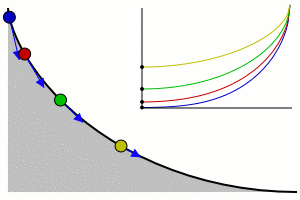- Tautochrone curve

300px|right|thumb|Four points run over a cycloid from different positions, but theyarrive at the bottom at the same time. The blue arrows show the points' acceleration. On the top is the time-position diagram.A tautochrone or isochrone curve is the curve for which the time taken by an object sliding without friction in uniform
gravity to its lowest point is independent of its starting point. The curve is acycloid , and the time is equal to π times thesquare root of the radius over the acceleration of gravity.The tautochrone problem
The tautochrone problem, the attempt to identify this curve, was solved by
Christiaan Huygens in1659 . He proved geometrically in his "Horologium oscillatorium" ("The Pendulum Clock",1673 ) that the curve was acycloid . This solution was later used to attack the problem of thebrachistochrone curve .Jakob Bernoulli solved the problem using calculus in a paper ("Acta Eruditorum ",1690 ) that saw the first published use of the termintegral .Later mathematicians such as
Joseph Louis Lagrange andLeonhard Euler looked for an analytical solution to the problem."Virtual gravity" solution
Perhaps the simplest solution to the tautochrone problem is to note a direct relation between the angle of an incline and the gravity felt by a particle on the incline. A particle on a 90° vertical incline feels the full effect of gravity, while a particle on a horizontal plane feels effectively no gravity. At intermediate angles, the "virtual gravity" felt by the particle is . The first step is to find a "virtual gravity" that produces the desired behavior.
The "virtual gravity" required for the tautochrone is simply proportional to the distance remaining to be traveled, which admits a simple solution:
:
:
It can be easily verified both that this solution solves the differential equation and that a particle will reach at time from any starting height . The problem is now to construct a curve that will produce a "virtual gravity" proportional to the distance remaining to travel, i.e, a curve that satisfies:
:
The explicit appearance of the distance remaining is troublesome, but we can differentiate to obtain a more manageable form:
:
or
:
This equation relates the change in the curve's angle to the change in the distance along the curve. We now use the
Pythagorean theorem , the fact that the slope of the curve is equal to the tangent of its angle, and sometrigonometric identities to obtain is terms of ::
Substituting this into the first differential equation lets us solve for in terms of :
:
Likewise, we can also express in terms of and solve for in terms of :
:
Substituting and , we see that these equations for and are those of a circle rolling along a horizontal line — a
cycloid ::
Solving for and remembering that is the time required for descent, we find the descent time in terms of the radius :
:
(Based loosely on "Proctor", pp. 135-139)
Abel's solution
Abel attacked a generalized version of the tautochrone problem ("Abel's mechanical problem"), namely, given a function that specifies the total time of descent for a given starting height, find an equation of the curve that yields this result. The tautochrone problem is a special case of Abel's mechanical problem when is a constant.
Abel's solution begins with the principle of
conservation of energy — since the particle is frictionless, and thus loses no energy toheat , itskinetic energy at any point is exactly equal to the difference inpotential energy from its starting point. The kinetic energy is , and since the particle is constrained to move along a curve, its velocity is simply , where is the distance measured along the curve. Likewise, the gravitational potential energy gained in falling from an initial height to a height is , thus::
In the last equation, we've anticipated writing the distance remaining along the curve as a function of height (), recognized that the distance remaining must decrease as time increases (thus the minus sign), and used the
chain rule in the form .Now we integrate from to to get the total time required for the particle to fall:
:
This is called Abel's integral equation and allows us to compute the total time required for a particle to fall along a given curve (for which would be easy to calculate). But Abel's mechanical problem requires the converse — given , we wish to find , from which an equation for the curve would follow in a straightforward manner. To proceed, we note that the integral on the right is the
convolution of with and thus take theLaplace transform of both sides::
Since , we now have an expression for the Laplace transform of in terms of 's Laplace transform:
:
This is as far as we can go without specifying . Once is known, we can compute its Laplace transform, calculate the Laplace transform of and then take the inverse transform (or try to) to find .
For the tautochrone problem, is constant. Since the Laplace transform of 1 is , we continue:
:
Making use again of the Laplace transform above, we invert the transform and conclude:
:
It can be shown that the cycloid obeys this equation.
("Simmons", Section 54).
External links
* [http://mathworld.wolfram.com/TautochroneProblem.html Mathworld]
Bibliography
* Simmons, George, "Differential Equations with Applications and Historical Notes," McGraw-Hill, 1972. ISBN 0-07-057540-1.
* Proctor, Richard, [http://historical.library.cornell.edu/cgi-bin/cul.math/docviewer?did=02260001&seq=9 A Treatise on The Cycloid and all forms of Cycloidal Curves] (1878), posted by [http://historical.library.cornell.edu/math/index.html Cornell University Library] .
Wikimedia Foundation. 2010.
